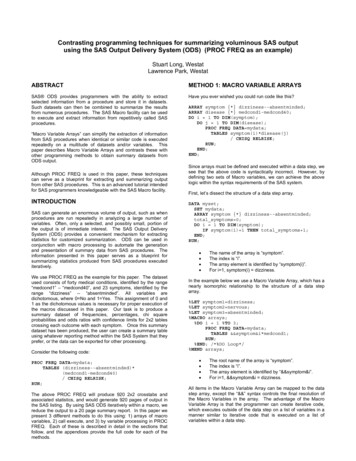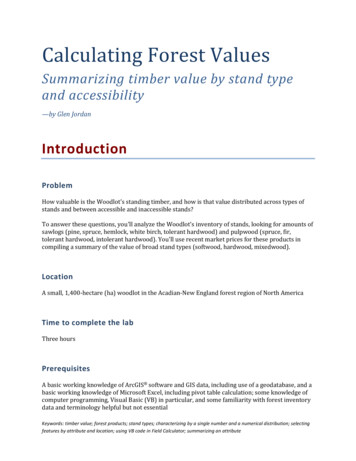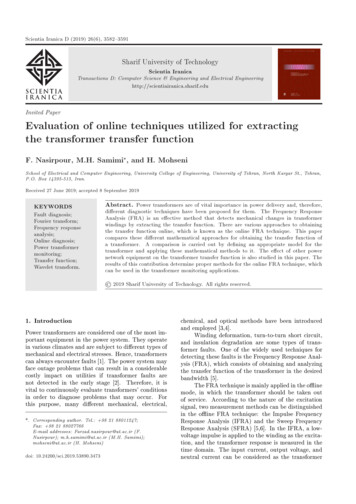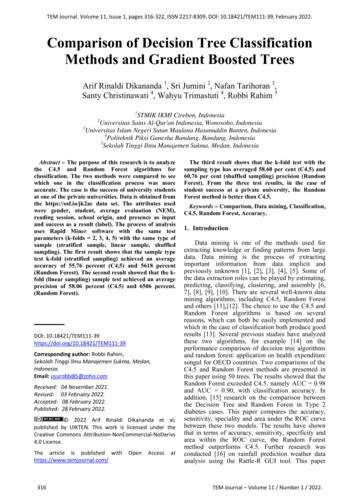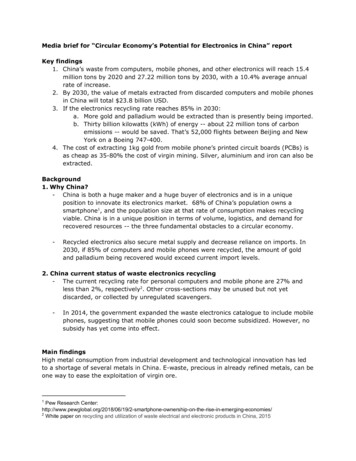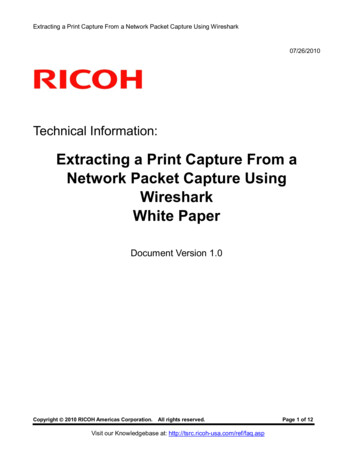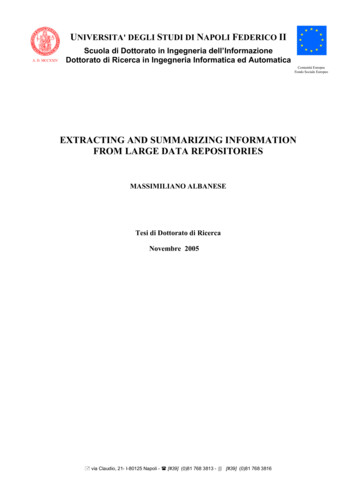
Transcription
UNIVERSITA' DEGLI STUDI DI NAPOLI FEDERICO IIA. D. MCCXXIVScuola di Dottorato in Ingegneria dell’InformazioneDottorato di Ricerca in Ingegneria Informatica ed AutomaticaComunità EuropeaFondo Sociale EuropeoEXTRACTING AND SUMMARIZING INFORMATIONFROM LARGE DATA REPOSITORIESMASSIMILIANO ALBANESETesi di Dottorato di RicercaNovembre 2005 via Claudio, 21- I-80125 Napoli -[#39] (0)81 768 3813 - [#39] (0)81 768 3816
UNIVERSITA' DEGLI STUDI DI NAPOLI FEDERICO IIA. D. MCCXXIVScuola di Dottorato in Ingegneria dell’InformazioneDottorato di Ricerca in Ingegneria Informatica ed AutomaticaEXTRACTING AND SUMMARIZING INFORMATIONFROM LARGE DATA REPOSITORIESMASSIMILIANO ALBANESETesi di Dottorato di Ricerca(XVIII ciclo)Novembre 2005Il TutoreIl Coordinatore del DottoratoProf. Antonio PICARIELLOProf. Luigi Pietro CORDELLAIl Co-TutoreProf. V.S. SUBRAHMANIANDipartimento di Informatica e Sistemistica via Claudio, 21- I-80125 Napoli -[#39] (0)81 768 3813 - [#39] (0)81 768 3816
AbstractInformation retrieval from large data repositories has become an important area of computer science. Research in this field is highly encouraged bythe ever-increasing rate with which today’s society is able to produce digitaldata. Unfortunately most of such data (e.g. video recordings, plain textdocuments) are unstructured. Two major issues thus arise in this scenario:i) extracting structured data – information – from unstructured data; ii)summarizing information, i.e. reducing large volumes of information to ashort summary or abstract comprising only the most essential facts.In this thesis, techniques for extracting and summarizing informationfrom large data repositories are presented. In particular the attention isfocused onto two kinds of repositories: video data collections and naturallanguage text document repositories. We show how the same principlescan be applied for summarizing information in both domains and presentsolutions tailored to each domain. The thesis presents a novel video summarization algorithm, the Priority Curve Algorithm, that outperforms previoussolutions, and three heuristic algorithms, OptStory , GenStory and DynStory,for creating succinct stories about entities of interest using the informationcollected by algorithms that extract structured data from heterogenous datasources. In particular a Text Attribute Extraction (TAE) algorithm for extracting information from natural language text is presented. Experimentalresults show that our approach to summarization is promising.I
AcknowledgementsThis work would certainly not have been possible without the supportof many people. I’d like to acknowledge Prof. Lucio Sansone, who has beenmy master thesis’ advisor, for having given me lots of useful suggestions. I’dlike to thank Prof. Antonio Picariello, my master thesis’ co-advisor and myPh.D. thesis advisor, for having guided me during these years. I’d like tothank Prof. V.S. Subrahmanian at University of Maryland, my Ph.D. thesis’co-advisor, for having given me the chance to spend several months at hislaboratory and start the challenging projects around which the work presented in this thesis is built. I’d like to acknowledge Prof. Angelo Chianese,the other cornerstone of our research group together with Prof. Sansone, forhaving helped me to start my experience at University of Naples. I’d like tothank Prof. Luigi Cordella, chair of Naples’ Ph.D. School in Computer Science and Engineering, for dedicating so much of his time to the School. I’dlike to acknowledge Prof. Carlo Sansone, who has guided me in a researchactivity that is not mentioned in this work.I’d also like to acknowledge all friends, colleagues and relatives whosupported me in these years. Finally, I’d like to acknowledge myself forhaving had the willingness to pursue this goal.II
Table of ContentsIState of the Art11 Introduction1.12Information Retrieval from Large Data Repositories . . . . .21.1.1Information versus Data Retrieval . . . . . . . . . . .31.1.2Focus of the Thesis . . . . . . . . . . . . . . . . . . . .51.2Information Extraction . . . . . . . . . . . . . . . . . . . . . .81.3Information Summarization . . . . . . . . . . . . . . . . . . .101.3.1Evaluation Strategies and Metrics . . . . . . . . . . .11Conclusions . . . . . . . . . . . . . . . . . . . . . . . . . . . .121.42 Related works2.12.213Video Databases . . . . . . . . . . . . . . . . . . . . . . . . .132.1.1Video Data Management . . . . . . . . . . . . . . . .142.1.2Video Information Retrieval . . . . . . . . . . . . . . .162.1.3Video Segmentation . . . . . . . . . . . . . . . . . . .172.1.4Video Summarization . . . . . . . . . . . . . . . . . .212.1.4.1Physical Video Property Based Methods . .222.1.4.2Semantic Video Property Class . . . . . . . .262.1.4.3An Alternative Classification of Summarization Methods . . . . . . . . . . . . . . . . . .28Text Documents . . . . . . . . . . . . . . . . . . . . . . . . .292.2.1Text Summarization . . . . . . . . . . . . . . . . . . .292.2.2Automatic Story Creation . . . . . . . . . . . . . . . .31III
TABLE OF CONTENTSIITheory343 Extraction and Summarization of Information from VideoDatabases353.1Introduction . . . . . . . . . . . . . . . . . . . . . . . . . . . .353.2Video Summarization: the CPR Model . . . . . . . . . . . . .363.2.1Formal Model . . . . . . . . . . . . . . . . . . . . . . .363.2.1.1Summarization Content Specification . . . .363.2.1.2Priority Specification . . . . . . . . . . . . .383.2.1.3Continuity Specification . . . . . . . . . . . .383.2.1.4Repetition Specification . . . . . . . . . . . .393.2.1.5Optimal Summary . . . . . . . . . . . . . . .39Summarization Algorithms . . . . . . . . . . . . . . .403.2.2.1The Optimal Summarization Algorithm . . .413.2.2.2The CPRdyn Algorithm . . . . . . . . . . . .413.2.2.3The CPRgen Algorithm . . . . . . . . . . . .423.2.2.4The Summary Extension Algorithm (SEA) .433.2.23.3The Priority Curve Algorithm (PriCA) for Video Summarization 443.3.1Overview of PriCA . . . . . . . . . . . . . . . . . . . .453.3.2Details of PriCA Components . . . . . . . . . . . . . .483.3.2.1Block Creation Module . . . . . . . . . . . .483.3.2.2Priority Assignment Module . . . . . . . . .503.3.2.3Peak Identification Module . . . . . . . . . .503.3.2.4Block Merging Module . . . . . . . . . . . .563.3.2.5Block Elimination Module . . . . . . . . . .593.3.2.6Block Resizing Module . . . . . . . . . . . .634 Automatic Creation of Stories664.1Introduction . . . . . . . . . . . . . . . . . . . . . . . . . . . .664.2Story Schema and Instance . . . . . . . . . . . . . . . . . . .684.3Story Computation Problem . . . . . . . . . . . . . . . . . . .724.3.1Valid and Full Instances . . . . . . . . . . . . . . . . .734.3.2Stories . . . . . . . . . . . . . . . . . . . . . . . . . . .754.3.3Optimal Stories . . . . . . . . . . . . . . . . . . . . . .78IV
TABLE OF CONTENTS4.44.5Story Computation . . . . . . . . . . . . . . . . . . . . . . . .804.4.1Restricted Optimal Story Algorithm . . . . . . . . . .814.4.2Genetic Programming Approach . . . . . . . . . . . .824.4.3Dynamic Programming Approach . . . . . . . . . . . .82Story Rendering . . . . . . . . . . . . . . . . . . . . . . . . .835 Information Extraction from Text Sources5.1III87Attribute Extraction . . . . . . . . . . . . . . . . . . . . . . .875.1.1Attribute Extraction from Text Sources . . . . . . . .875.1.2Named Entity Recognition . . . . . . . . . . . . . . .925.1.3Attribute Extraction from Relational and XML Sources 95Experiments and Conclusions6 Video Summaries97986.1Implementation . . . . . . . . . . . . . . . . . . . . . . . . . .6.2Experimental Setting . . . . . . . . . . . . . . . . . . . . . . . 1006.3Qualitative Evaluation . . . . . . . . . . . . . . . . . . . . . . 1016.4Execution Times . . . . . . . . . . . . . . . . . . . . . . . . . 1037 Story System Evaluation981047.1Introduction . . . . . . . . . . . . . . . . . . . . . . . . . . . . 1047.2Story Quality . . . . . . . . . . . . . . . . . . . . . . . . . . . 1057.37.2.1Experimental Setting . . . . . . . . . . . . . . . . . . . 1057.2.2Non-Expert Reviewers . . . . . . . . . . . . . . . . . . 1067.2.3Expert Reviewers . . . . . . . . . . . . . . . . . . . . . 107Execution Times . . . . . . . . . . . . . . . . . . . . . . . . . 1108 Discussion and Conclusions1128.1Conclusions . . . . . . . . . . . . . . . . . . . . . . . . . . . . 1128.2Future Work . . . . . . . . . . . . . . . . . . . . . . . . . . . 114V
List of Figures3.1Architecture of the PriCA framework . . . . . . . . . . . . . .453.2Example of peaks in the priority function . . . . . . . . . . .523.3Peaks() algorithm analyzing a peak . . . . . . . . . . . . . . .543.4Result of running Peaks() Algorithm . . . . . . . . . . . . . .555.1Extraction rules. . . . . . . . . . . . . . . . . . . . . . . . .895.2Data extraction: (a) analyzed sentence; (b) matching rule . .926.1Indexing and query interface . . . . . . . . . . . . . . . . . .996.2Summarization interface . . . . . . . . . . . . . . . . . . . . .996.3Summarization result . . . . . . . . . . . . . . . . . . . . . . . 1006.4Summary quality ratings6.5Summary creation times . . . . . . . . . . . . . . . . . . . . . 1037.1Non-expert reviewers: (a) Story Value and (b) Prose Quality 1067.2Non-expert reviewers: average Story Value and Prose Quality 1077.3Expert reviewers: (a) Story Value and (b) Prose Quality . . . 1087.4Expert reviewers: average Story Value and Prose Quality . . 1087.5Experts vs. non-experts Comparison . . . . . . . . . . . . . . 1097.6Comparison between execution times . . . . . . . . . . . . . . 110. . . . . . . . . . . . . . . . . . . . 102VI
List of Tables1.1Data Retrieval versus Information Retrieval . . . . . . . . . .5.1Recall and precision performance of the Named Entity Recognition Algorithm . . . . . . . . . . . . . . . . . . . . . . . . .VII495
Part IState of the Art1
Chapter 1Introduction1.1Information Retrieval from Large Data RepositoriesInformation retrieval (IR) deals with the representation, storage, organization of, and access to information items. The representation and organization of the information items should provide the user with easy accessto the information in which he/she is interested. Given a user query, thekey goal of an IR system is to retrieve information which might be useful orrelevant to the user. Unfortunately, characterization of the user informationneed is not a simple problem. On the other hand, the explosive growth ofdigital technologies has made available huge amounts of data, making theproblem of retrieving information even more complex. Such great amountsof data also require a new capability for any modern information retrievalsystem: the capability of automatically summarizing large data sets in orderto produce compact overviews of them.Information retrieval is a wide, often loosely-defined term. Unfortunatelythe word information can be very misleading. In the context of information retrieval, information is not readily measured in the technical meaninggiven in Shannon’s theory of communication [57]. In fact, in many casesone can adequately describe the kind of retrieval by simply substituting“document” for “information”. Nevertheless, “information retrieval” hasbecome accepted as a description of the kind of work published by SparckJones [61], Lancaster [34] and others. A perfectly straightforward defini-2
1.1 Information Retrieval from Large Data Repositoriestion along these lines is given by Lancaster [34]: “Information retrieval isthe term conventionally, though somewhat inaccurately, applied to the typeof activity discussed in this volume. An information retrieval system doesnot inform (i.e. change the knowledge of ) the user on the subject of his inquiry. It merely informs on the existence (or non-existence) and whereaboutsof documents relating to his request.” This definition specifically excludesQuestion Answering systems and Semantic Information Processing systems.It also excludes data retrieval systems such as those used by, for instance,the stock exchange for on-line quotations.1.1.1Information versus Data RetrievalData retrieval (DR), in the context of an IR system, consists mainly ofdetermining which documents of a collection contain the keywords in theuser query which, most frequently, is not enough to satisfy user informationneeds. In fact, the user of an IR system is concerned more with retrieving information about a subject than with retrieving data which satisfies agiven query. A data retrieval language aims at retrieving all objects whichsatisfy clearly defined conditions such as those in a regular expression or ina relational algebra expression. Thus, for a data retrieval system, a singleerroneous object among a thousand of retrieved objects means total failure.For an information retrieval system, however, the retrieved objects mightbe inaccurate and small errors are likely to go tolerated. The main reasonfor this difference is that information retrieval usually deals with naturallanguage text which is not always well structured and could be semanticallyambiguous. On the other hand, a data retrieval system (such as a relationaldatabase management system) deals with data that has a well defined structure and semantics. Data retrieval, while providing a solution to the userof a database system, does not solve the problem of retrieving informationabout a subject or topic. To be effective in its attempt to satisfy user information needs, the IR system must somehow “interpret” the contents ofthe information items (documents) in a collection and rank them accordingto a degree of relevance to the user query. This “interpretation” of a document content involves extracting syntactic and semantic information from3
1.1 Information Retrieval from Large Data ationQuery languageQuery specificationItems wantedError responseData RetrievalExact pleteMatchingSensitiveInformation RetrievalPartial match, best leteRelevantInsensitiveTable 1.1: Data Retrieval versus Information Retrievalthe document text and using this information to match user informationneeds. The difficulty is not only knowing how to extract this informationbut also knowing how to use it to decide relevance. Thus, the notion ofrelevance is central to information retrieval. In fact, the primary goal of anIR system is to retrieve all the documents which are relevant to a user querywhile retrieving as few non-relevant documents as possible.Table 1.1 lists some of the distinguishing properties of data and information retrieval. Let us now consider each item in the table in more details.In data retrieval we are normally looking for an exact match, that is, weare checking to see whether an item satisfies or not certain properties. Ininformation retrieval we usually want to find those items which partiallymatch the request and then select from them the best matching ones.The inference used in data retrieval is of the simple deductive kind.In information retrieval it is far more common to use inductive inference;relations are only specified with a degree of certainty or uncertainty andhence our confidence in the inference is variable. This distinction leadsone to describe data retrieval as deterministic but information retrieval asprobabilistic. Frequently Bayes’ Theorem is invoked to carry out inferencesin IR, but in DR probabilities do not enter into the processing.Another distinction can be made in terms of classifications that are likelyto be useful. In DR we are most likely to be interested in a monothetic classification, that is, one with classes defined by objects possessing attributesthat are both necessary and sufficient to belong to a class. In IR polythetic4
1.1 Information Retrieval from Large Data Repositoriesclassification is used instead. In such a classification each member of a classwill possess only some of all the attributes possessed by all the members ofthat class. Hence no attribute is necessary nor sufficient for membership toa class.The query language for DR will generally be of the artificial kind, onewith restricted syntax and vocabulary, while in IR natural language is preferred although there are some notable exceptions. In DR the query is generally a complete specification of what is wanted, while in IR it is invariablyincomplete. This last difference arises partly from the fact that in IR weare searching for relevant documents as opposed to exactly matching items.The extent of the match in IR is assumed to indicate the likelihood of therelevance of that item. One simple consequence of this difference is that DRis more sensitive to errors, in the sense that an error in matching will notretrieve the wanted item, which implies a total failure of the system. In IRsmall errors in matching generally do not affect performance of the systemsignificantly.1.1.2Focus of the ThesisThe topic of this thesis is related to the general area of information retrieval. In particular the work focuses on extracting and summarizing information from large data repositories and presents techniques and algorithmsto identify succinct subsets of larger data sets: such techniques are appliedto different kinds of data. Two major scenarios are considered throughoutthe thesis: digital video collections and the world wide web (or any othercollection of text documents). In fact it is well known that digital videodata represent the most voluminous type of data in the field of multimediadatabases. On the other hand, the world wide web represents nowadays ahuge and global information repository, counting billions of documents.From an IR point of view, both digital video and text documents represent unstructured data: the information content embedded in such objectis not immediately usable by an IR system. It is easy to access the secondparagraph of a text document or the last 5 minutes of a videoclip, but it isnot that trivial to access the first paragraph that deals with a certain topic5
1.1 Information Retrieval from Large Data Repositoriesor the video segment in which a certain action occurs. Section 1.1.1 pointedout that, in order to be effective in its attempt to satisfy user informationneeds, an IR system must somehow “interpret” the content of the documentsin a collection and rank them according to a degree of relevance to the userquery. This “interpretation” of a document content involves the extractionof syntactic and semantic information from the document and the abilityto use this information to match user information needs. If we assume thatthe primary goal of an IR system is to retrieve all the documents which arerelevant to a user query while retrieving as few non-relevant documents aspossible, an overall interpretation of each document may be enough to selectthe relevant documents (an entire text or an entire video).However with the exponential growth of the amounts of available data, asecond level of abstraction of information from the results of the first roundof IR becomes necessary. That is, the large number of documents returnedby IR systems need to be summarized, in order to reduce the large volumeof information to a short summary or abstract comprising only the most essential items. An overall interpretation of each document is not still enoughto perform this new task, but detailed understanding of any single piece ofinformation in a document is required: knowledge/information extractiontechniques are thus required to represent the information content of a document in a well structured way. Information extraction also enables otherapplications such as Question Answering (QA), that allows to get targetedand precise answers to specific questions.In this work we present knowledge extraction and summarization techniques tailored to each of the two scenarios mentioned above. The reason fordealing with such different scenarios is that both of them require to addresssimilar issues in order to achieve the goal of the summarization task, independently from the inherently different nature of the two kinds of data. Infact, we will show as the same criteria and similar algorithms can be appliedto solve the two problems.In the video databases context, we will show that the knowledge extraction phase requires the segmentation of videoclips into meaningful units(shots and scenes) and the identification of events occurring and objects6
1.1 Information Retrieval from Large Data Repositoriesappearing in each unit, while, the summarization task requires the selectionof a subset of those units, such that certain constraints (e.g. the maximumallowed length for the summary) and properties (e.g. continuity and norepetition) are satisfied.In the context of text documents we propose a technique to extractstructured information from natural language text and use such informationto build succinct stories about people, places, events, etc., such that certainconstraints and properties are satisfied.The major contributions of this work are the Priority Curve Algorithm (PriCA) for video summarization; the Text Attribute Extraction (TAE) Algorithm for extracting structured information from natural language text; a Named Entity Recognition algorithm (T-HMM) for recognizing ina set of text documents the entities of interest to a given knowledgedomain; three heuristic algorithms (OptStory , GenStory and DynStory) for generating stories out of the information collected by the TAE algorithm.The thesis is organized as follows. The remainder of this chapter introduces the basic concepts of information extraction end summarization.Chapter 2 describes the state of the art in both video summarization andautomatic story creation, also discussing several related issues. Chapters 3,4 and 5 present the original contributions of this work. Chapter 3 first introduces the CPR model for video summarization, then presents the PriCAframework – based on the Priority Curve Algorithm – that integrates videosegmentation, event detection and video summarization capabilities. Chapter 4 describes the theoretical foundation of our story creation frameworkand presents three heuristic algorithms for building stories, namely OptStory ,GenStory and DynStory. The Text Attribute Extraction (TAE) algorithm andthe named entity recognition algorithm (T-HMM) are presented in Chapter 5. An approach to extracting attribute values from relational and XML7
1.2 Information Extractiondata sources is also presented in this chapter. Chapters 6 and 7 describeexperiments carried out to validate our approach to video summarizationand story creation respectively. Conclusions and discussion about futuredevelopments are reported in Chapter 8.1.2Information ExtractionMany people and organizations need to access specific types of information in some domain of interest. For example, financial analysts may need tokeep track of joint ventures and corporate mergers. Executive head huntersmay want to monitor the corporate management changes and search forpatterns in these changes. Information about these events is typically available from newspapers and various newswire services. Information retrievalsystems can be used to sift through large volumes of data and find relevantdocuments1 containing the information of interest. However, humans stillhave to analyze the documents to identify the desired information. The objective of Information Extraction (IE) is to address the need to collect theinformation (instead of documents containing the information) from largevolumes of unrestricted text or any other kind of data.The extracted information may be more valuable than the original datain several ways. While the documents returned by information retrieval systems have tobe analyzed by humans, the database entries returned by informationextraction systems can be processed by data processing algorithms. Information extraction also allows to answer queries that could beanswered by information retrieval systems.We now briefly compare information extraction with both informationretrieval and text understanding. Of course some of the following considerations specifically apply to information extraction from text documents,but similar issues arise for other kinds of data.1We often use the term document to denote a generic multimedia document – a textdocument, a video, etc.8
1.2 Information ExtractionInformation extraction is a much more difficult task than informationretrieval. In fact it involves: accurate recognition of the entities in documents: organizations, persons, locations, time, money, etc.; co-reference recognition; identification of relationships between entities and events; domain specific inference.On the other hand, information extraction is a much easier and moretractable task than text understanding, because: its goal is narrowly focused on extracting particular types of information determined by a set of pre-defined extraction criteria; the inferences IE systems are required to make are much more restricted than a general natural language understanding system; due to its narrow focus, an IE system can largely ignore words orconcepts that are outside its domain of interest.Message Understanding Conference (MUC) is a DARPA sponsored conference in which participating IE systems are rigourously evaluated. Information extracted by the systems from blind test sets of text documents arecompared and scored against information manually extracted by human analysts. Information extraction in the sense of the Message UnderstandingConferences has been traditionally defined as the extraction of informationfrom a text in the form of text strings and processed text strings whichare placed into slots labeled to indicate the kind of information that theyrepresent. So, for example, a slot labeled NAME would contain a name stringtaken directly out of the text or modified in some well-defined way, such asby deleting all but the person’s surname. The input to information extraction is a set of texts, usually unclassified newswire articles, and the outputis a set of filled slots. The set of filled slots may represent an entity with9
1.3 Information Summarizationits attributes, a relationship between two or more entities, or an event withvarious entities playing roles and/or being in certain relationships. Entitieswith their attributes are extracted in the Template Element task; relationships between two or more entities are extracted in the Template Relationtask; and events with various entities playing roles and/or being in certainrelationships are extracted in the Scenario Template task.1.3Information SummarizationSummarizing is the process of reducing a large volume of informationto a short summary or abstract comprising only the most essential information items. Summarizing is frequent in everyday communication, butit is also a professional skill for journalists and scientific writers. Automated summarizing functions are needed by internet users who wish to exploit the information available without being overwhelmed. The primaryapplication of summarization is thus that of summarizing the set of documents returned by an information retrieval system. Many other uses ofsummarization techniques are possible: information extraction, as opposedto document-retrieval; automatic generation of comparison charts; just-intime knowledge acquisition; finding answers to specific questions; tools forinformation retrieval in multiple languages; biographical profiling.The approach and the end-objective of summarization of documents explain the kind of summary that is generated. For example, it could beindicative of what a particular subject is about, or can be informative aboutspecific details of the same. It can differ in being a “generalized summary”of a document as against a “query-specific summary”. Summaries may beclassified by any of the following criteria [43]:Detail: indicative/informativeGranularity: specific events/overviewTechnique: extraction/abstractionContent: generalized/query-based10
1.3 Information SummarizationApproach: domain(genre) specific/independent1.3.1Evaluation Strategies and MetricsHuman judgment of the quality of a summary varies from person toperson. For example, in a study conducted by Goldstein et al. [20], whena few people were asked to pick the most relevant sentences in a givendocument, there was very little overlap of the sentences picked by differentpersons. Also, human judgment usually does not find concurrence on thequality of a given summary. Hence it is difficult to quantify the quality of asummary. However, a few indirect measures may be adopted that indicatethe usefulness and completeness of a summary [19, 25, 43, 49], such as:1. Can a user answer all the questions by reading a summary, as hewould by reading the entire document from which the summary wasproduced?2. What is the compression ratio between the given document and itssummary?3. If it is a summary of multiple documents with temporal dimension,does it capture the correct temporal information?4. Redundancy – is any information repeated in the summary?5. Intelligibility – is the information in the summary easy to understand?6. Cohesion – are the information items in the summary somehow relatedto each other?7. Coherence – is the information in the summary organized accordingto some logic?8. Readability (depends on cohesion/coherence/intelligibility)The latter four qualities of summaries are usually difficult to measure.The last one specifically applies to text summaries while the other ones canbe used to evaluate any kind of summary. A metric is said to be intrinsic or11
1.4 Conclusionsextrinsic depending on whether the metric determines the quality based onthe summary alone, or based on the usefulness of the summary in completinganother task [19].For example, the
ambiguous. On the other hand, a data retrieval system (such as a relational database management system) deals with data that has a well de ned struc-ture and semantics. Data retrieval, while providing a solution to the user of a database system, does not solve the problem of retrieving information about a subject or topic.
